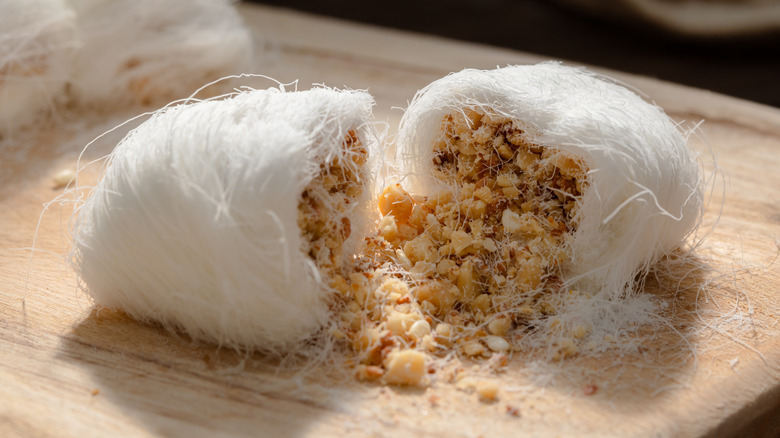Dragon's Beard Candy Is An Ancient Chinese Confectionery Similar To This Carnival Classic
Dragon's Beard candy is considered one of the hardest candies to make because of the temperamental and tedious process behind its creation. Its origin is often disputed, but it's generally regarded as having been invented during China's Han dynasty. While it may be an old and complicated sweet treat, it's often compared to one that's a bit more commonplace in modern times: cotton candy.
The similarities between the two are undeniable, but there are some differences. Both are a spectacle to watch, but cotton candy can be made by almost anyone, anywhere. Dragon's Beard candy, on the other hand, is a difficult art to master, often taking years to learn from skilled artisans. It was regarded as having originated from Chinese royalty, partly because of how labor-intensive it is to make.
While cotton candy is made by spinning melted sugar crystals into a floss, Dragon's Beard candy is much more complicated. Cotton candy machines make the process easy by allowing anyone to pour sugar inside and yield cotton candy after only a few minutes of heating and spinning. On the other hand, Dragon's Beard candy takes practiced heating, pulling, flouring, and rolling to create an amazing product.
How to make Dragon's Beard candy
While cotton candy's history may be traced back to ancient times via Dragon's Beard candy and other treats around the world, the process of weaving a dragon's beard is much more involved. First, you have to melt a combination of sugar, corn syrup, and vinegar to an exact temperature of 270 degrees Fahrenheit. This mixture can vary depending on the recipe, but this seems to yield the most consistent results.
Once that mixture has reached the proper temperature, it has to be poured into puck-shaped molds and cooled. Some people will use a donut-shaped mold to create a hole in the center as a starting point, but others will poke a hole in the puck to start the loop from there. It then needs to be dusted with corn starch or rice flour to maintain its consistency without sticking while being pulled into strands.
This technique is where the process gets difficult. Once you start pulling on the loop of candy, it's easy to break and ruin the strands. The goal is to repeatedly twist and pull the loop until it's the consistency of hair, if not finer. This is achieved by repeating the process 10 to 20 times, with 20 twists giving you over one million strands of candy, if done correctly. From there, the similarity to cotton candy ends, with the pulled candy often being wrapped around crushed nuts, sesame seeds, or coconut and eaten in small chunks.

